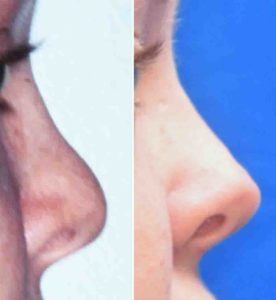Background: Rhinoplasty surgery often entails the need for grafts. Most commonly cartilage grafts from the septum or ear are used as the volume needs are low and it is helpful to have a convenient and anatomically close harvest site. But major nasal reconstruction may need much larger graft volumes for which the rib offers a near limitless amount.
But in some nasal reconstruction cases where other craniofacial work is being performed, the most convenient donor site is one in which it is already open…the skull. Split-thickness cranial bone grafts have a long history of use in facial reconstruction including for reconstruction of the nose.
In reality, cranial bone is not the best graft for use in the nose because it is rigid and has to be made straight by either burring or controlled bending through partial osteotomy cuts. One must also be careful that it does not put a lot of pressure on the nasal tip skin to prevent soft tissue breakdown. But if careful graft shaping is done, as well as bone fixation if needed, successful outcomes can be obtained with its use.
Case Study: This young female has been involved in a motor vehicle accident and sustained multiple craniofacial fractures of the forehead and midface. While these fractures underwent primary repair she remained with numerous residual brow bone, orbital and nasal deformities.


Cranial bone is not a primary source for nasal reconstruction grafting due to the limitations of its rigid structure. But if open access to the skull is already present for other procedures, it can make be used successfully.
Highlights:
- Cranial bone is one secondary option for dorsal grafting in rhinoplasty.
- The curved nature of cranial bone requires graft bending techniques for a straight dorm.
- A dorsal bone graft often needs to be combined with a columellar strut for an L-shaped nasal reconstruction.
Dr. Barry Eppley
Indianapolis, Indiana


